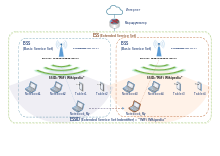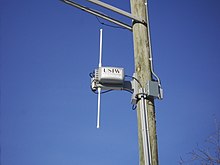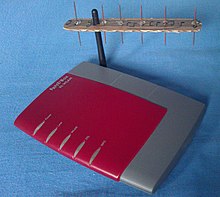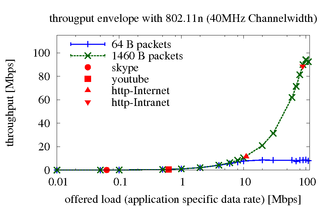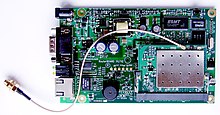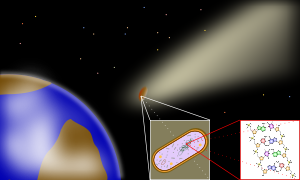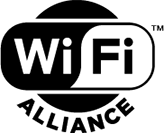
Wi-Fi Alliance
| |
| Introduced | September 1998 |
|---|---|
| Compatible hardware | Personal computers, gaming consoles, televisions, printers, mobile phones |
Wi-Fi is a family of wireless networking technologies, based on the IEEE 802.11 family of standards, which are commonly used for local area networking of devices and Internet access. Wi‑Fi is a trademark of the non-profit Wi-Fi Alliance, which restricts the use of the term Wi-Fi Certified to products that successfully complete interoperability certification testing. As of 2010, the Wi-Fi Alliance consisted of more than 375 companies from around the world. As of 2009, Wi-Fi-integrated circuit chips shipped approximately 580 million units annually. Devices that can use Wi-Fi technologies include desktops and laptops, smartphones and tablets, smart TVs, printers, digital audio players, digital cameras, cars and drones.
Wi-Fi uses multiple parts of the IEEE 802 protocol family and is designed to seamlessly interwork with its wired sibling Ethernet. Compatible devices can network through a wireless access point to each other as well as to wired devices and the Internet. The different versions of Wi-Fi are specified by various IEEE 802.11 protocol standards, with the different radio technologies determining radio bands, and the maximum ranges, and speeds that may be achieved. Wi-Fi most commonly uses the 2.4 gigahertz (120 mm) UHF and 5 gigahertz (60 mm) SHF ISM radio bands; these bands are subdivided into multiple channels. Channels can be shared between networks but only one transmitter can locally transmit on a channel at any moment in time.
Wi-Fi's wavebands have relatively high absorption and work best for line-of-sight use. Many common obstructions such as walls, pillars, home appliances etc. may greatly reduce range, but this also helps minimize interference between different networks in crowded environments. An access point (or hotspot) often has a range of about 20 metres (66 feet) indoors while some modern access points claim up to a 150-metre (490-foot) range outdoors. Hotspot coverage can be as small as a single room with walls that block radio waves, or as large as many square kilometres using many overlapping access points with roaming permitted between them. Over time the speed and spectral efficiency of Wi-Fi has increased. As of 2019, at close range, some versions of Wi-Fi running on suitable hardware can achieve speeds of over 1 Gbit/s (gigabit per second).
Wi-Fi is potentially more vulnerable to attack than wired networks because anyone within range of a network with a wireless network interface controller can attempt access. Therefore to connect to a Wi-Fi network, a user typically needs the network name (the SSID) and a password. The password is used to encrypt Wi-Fi packets so as to block eavesdroppers. Wi-Fi Protected Access (WPA) is a family of technologies created to protect information moving across Wi-Fi networks and includes solutions for personal and enterprise networks. As the security landscape has changed over time security features of WPA have included stronger protections and new security practices.
History
In 1971, ALOHAnet connected the Great Hawaiian Islands with a UHF wireless packet network. ALOHAnet and the ALOHA protocol were early forerunners to Ethernet, and later the IEEE 802.11 protocols, respectively.
A 1985 ruling by the U.S. Federal Communications Commission released the ISM band for unlicensed use. These frequency bands are the same ones used by equipment such as microwave ovens and are subject to interference.
In 1991, NCR Corporation with AT&T Corporation invented the precursor to 802.11, intended for use in cashier systems, under the name WaveLAN.
The Australian radio-astronomer Dr John O'Sullivan with his colleagues Terence Percival, Graham Daniels, Diet Ostry, and John Deane developed a key patent used in Wi-Fi as a by-product of a Commonwealth Scientific and Industrial Research Organisation (CSIRO) research project, "a failed experiment to detect exploding mini black holes the size of an atomic particle". Dr O'Sullivan and his colleagues are credited with inventing Wi-Fi. In 1992 and 1996, CSIRO obtained patents for a method later used in Wi-Fi to "unsmear" the signal.
The first version of the 802.11 protocol was released in 1997,
and provided up to 2 Mbit/s link speeds. This was updated in 1999 with 802.11b to permit 11 Mbit/s link speeds, and this proved popular.
In 1999, the Wi-Fi Alliance formed as a trade association to hold the Wi-Fi trademark under which most products are sold.
Wi-Fi uses a large number of patents held by many different organizations. In April 2009, 14 technology companies agreed to pay CSIRO $1 billion for infringements on CSIRO patents. This led to Australia labeling Wi-Fi as an Australian invention, though this has been the subject of some controversy.
CSIRO won a further $220 million settlement for Wi-Fi
patent-infringements in 2012, with global firms in the United States
required to pay CSIRO licensing rights estimated at an additional $1
billion in royalties. In 2016, the wireless local area network Test Bed was chosen as Australia's contribution to the exhibition A History of the World in 100 Objects held in the National Museum of Australia.
Etymology and terminology
A
Japanese sticker indicating to the public that a location is within
range of a Wi-Fi network. A dot with curved lines radiating from it is a
common symbol for Wi-Fi, representing a point transmitting a signal.
An example of a service set called "WiFi Wikipedia" consisting of two Basic Service Sets. Notebook_My is able to automatically roam between the two BSSs, without the user having to explicitly connect to the second network.
The name Wi-Fi, commercially used at least as early as August 1999, was coined by the brand-consulting firm Interbrand. The Wi-Fi Alliance had hired Interbrand to create a name that was "a little catchier than 'IEEE 802.11b Direct Sequence'."
Phil Belanger, a founding member of the Wi-Fi Alliance who presided
over the selection of the name "Wi-Fi", has stated that Interbrand
invented Wi-Fi as a pun on the word hi-fi (high fidelity), a term for high-quality audio technology.
The name Wi-Fi has no further meaning, and was never officially a shortened form of "Wireless Fidelity". Nevertheless, the Wi-Fi Alliance used the advertising slogan "The Standard for Wireless Fidelity" for a short time after the brand name was created, and the Wi-Fi Alliance was also called the "Wireless Fidelity Alliance Inc" in some publications.
Interbrand also created the Wi-Fi logo. The yin-yang Wi-Fi logo indicates the certification of a product for interoperability.
Non-Wi-Fi technologies intended for fixed points, such as Motorola Canopy, are usually described as fixed wireless. Alternative wireless technologies include mobile phone standards, such as 2G, 3G, 4G, and LTE.
The name is sometimes written as WiFi, Wifi, or wifi,
but these are not approved by the Wi-Fi Alliance. IEEE is a separate,
but related, organization and their website has stated "WiFi is a short
name for Wireless Fidelity".
To connect to a Wi-Fi LAN, a computer must be equipped with a wireless network interface controller. The combination of a computer and an interface controller is called a station. Stations are identified by one or more MAC addresses.
Wi-Fi nodes often operate in infrastructure mode where all communications go through a base station. Ad-hoc mode refers to devices talking directly to each other without the need to first talk to an access point.
A service set
is the set of all the devices associated with a particular Wi-Fi
network. Devices in a service set need not be on the same wavebands or
channels. A service set can be local, independent, extended or mesh or a
combination.
Each service set has an associated identifier, the 32-byte Service Set Identifier (SSID), which identifies the particular network. The SSID is configured within the devices that are considered part of the network.
A Basic Service Set (BSS) is a group of stations
that all share the same wireless channel, SSID, and other wireless
settings that have wirelessly connected (usually to the same access
point). Each BSS is identified by a MAC address which is called the BSSID.
Certification
The IEEE does not test equipment for compliance with their standards. The non-profit Wi-Fi Alliance was formed in 1999 to fill this void—to establish and enforce standards for interoperability and backward compatibility, and to promote wireless local-area-network technology. As of 2010, the Wi-Fi Alliance consists of more than 375 companies and includes 3Com (now owned by HPE/Hewlett-Packard Enterprise), Aironet (now owned by Cisco), Harris Semiconductor (now owned by Intersil), Lucent (now owned by Nokia), Nokia and Symbol Technologies (now owned by Zebra Technologies). The Wi-Fi Alliance enforces the use of the Wi-Fi brand to technologies based on the IEEE 802.11 standards from the IEEE. This includes wireless local area network (WLAN) connections, device to device connectivity (such as Wi-Fi Peer to Peer aka Wi-Fi Direct), Personal area network (PAN), local area network (LAN) and even some limited wide area network
(WAN) connections. Manufacturers with membership in the Wi-Fi Alliance,
whose products pass the certification process, gain the right to mark
those products with the Wi-Fi logo.
Specifically, the certification process requires conformance to the IEEE 802.11 radio standards, the WPA and WPA2 security standards, and the EAP
authentication standard. Certification may optionally include tests of
IEEE 802.11 draft standards, interaction with cellular-phone technology
in converged devices, and features relating to security set-up,
multimedia, and power-saving.
Not every Wi-Fi device is submitted for certification. The lack
of Wi-Fi certification does not necessarily imply that a device is
incompatible with other Wi-Fi devices. The Wi-Fi Alliance may or may not sanction derivative terms, such as Super Wi-Fi, coined by the US Federal Communications Commission (FCC) to describe proposed networking in the UHF TV band in the US.
Versions
| Generation/IEEE Standard | Maximum Linkrate | |
|---|---|---|
| Wi‑Fi 6 (802.11ax) | 600–9608 Mbit/s | |
| Wi‑Fi 5 (802.11ac) | 433–6933 Mbit/s | |
| Wi‑Fi 4 (802.11n) | 72–600 Mbit/s | |
| 802.11g | 3–54 Mbit/s | |
| 802.11a | 1.5 to 54 Mbit/s | |
| 802.11b | 1 to 11 Mbit/s | |
| (Wi-Fi 1, Wi-Fi 2, Wi-Fi 3 are unbranded but have unofficial assignments) | ||
Equipment frequently support multiple versions of Wi-Fi. To
communicate, devices must use a common Wi-Fi version. The versions
differ between the radio wavebands they operate on, the radio bandwidth
they occupy, the maximum data rates they can support and other details.
Some versions permit the use of multiple antennas, which permits greater
speeds as well as reduced interference.
Historically, equipment has simply listed the versions of Wi-Fi using the name of the IEEE standard that it supports. In 2018,
the Wi-Fi alliance standardized generational numbering so that
equipment can indicate that it supports Wi-Fi 4 (if the equipment
supports 802.11n), Wi-Fi 5 (802.11ac) and Wi-Fi 6 (802.11ax). These
generations have a high degree of backward compatibility with previous
versions. The alliance have stated that the generational level 4, 5, or 6
can be indicated in the user interface when connected, along with the
signal strength.
The full list of versions of Wi-Fi is: 802.11a, 802.11b, 802.11g, 802.11n (Wi-Fi 4), 802.11h, 802.11i, 802.11-2007, 802.11-2012, 802.11ac (Wi-Fi 5), 802.11ad, 802.11af, 802.11-2016, 802.11ah, 802.11ai, 802.11aj, 802.11aq, 802.11ax (Wi-Fi 6), 802.11ay.
Uses
Internet access
Wi-Fi technology may be used to provide local network and Internet access
to devices that are within Wi-Fi range of one or more routers that are
connected to the Internet. The coverage of one or more interconnected access points (hotspots)
can extend from an area as small as a few rooms to as large as many
square kilometres. Coverage in the larger area may require a group of
access points with overlapping coverage. For example, public outdoor
Wi-Fi technology has been used successfully in wireless mesh networks in London. An international example is Fon.
Wi-Fi provides service in private homes, businesses, as well as
in public spaces. Wi-Fi hotspots may be set up either free-of-charge or
commercially, often using a captive portal webpage for access. Organizations, enthusiasts, authorities and businesses,
such as airports, hotels, and restaurants, often provide free or
paid-use hotspots to attract customers, to provide services to promote
business in selected areas.
Routers often incorporate a digital subscriber line modem or a cable modem and a Wi-Fi access point, are frequently set up in homes and other buildings, to provide Internet access and internetworking for the structure.
Similarly, battery-powered routers may include a cellular Internet radio modem
and Wi-Fi access point. When subscribed to a cellular data carrier,
they allow nearby Wi-Fi stations to access the Internet over 2G, 3G, or
4G networks using the tethering technique. Many smartphones have a built-in capability of this sort, including those based on Android, BlackBerry, Bada, iOS (iPhone), Windows Phone and Symbian,
though carriers often disable the feature, or charge a separate fee to
enable it, especially for customers with unlimited data plans. "Internet
packs" provide standalone facilities of this type as well, without use
of a smartphone; examples include the MiFi- and WiBro-branded devices. Some laptops that have a cellular modem card can also act as mobile Internet Wi-Fi access points.
Many traditional university campuses in the developed world provide at least partial Wi-Fi coverage. Carnegie Mellon University built the first campus-wide wireless Internet network, called Wireless Andrew, at its Pittsburgh campus in 1993 before Wi-Fi branding originated.
By February 1997, the CMU Wi-Fi zone was fully operational. Many
universities collaborate in providing Wi-Fi access to students and staff
through the Eduroam international authentication infrastructure.
City-wide
An outdoor Wi-Fi access point
In the early 2000s, many cities around the world announced plans to
construct citywide Wi-Fi networks. There are many successful examples;
in 2004, Mysore
(Mysuru) became India's first Wi-Fi-enabled city. A company called
WiFiyNet has set up hotspots in Mysore, covering the complete city and a
few nearby villages.
In 2005, St. Cloud, Florida and Sunnyvale, California, became the first cities in the United States to offer citywide free Wi-Fi (from MetroFi). Minneapolis has generated $1.2 million in profit annually for its provider.
In May 2010, London mayor Boris Johnson pledged to have London-wide Wi-Fi by 2012. Several boroughs including Westminster and Islington already had extensive outdoor Wi-Fi coverage at that point.
Officials in South Korea's capital Seoul
are moving to provide free Internet access at more than 10,000
locations around the city, including outdoor public spaces, major
streets and densely populated residential areas. Seoul will grant leases
to KT, LG Telecom, and SK Telecom. The companies will invest $44 million in the project, which was to be completed in 2015.
Geolocation
Wi-Fi positioning systems use the positions of Wi-Fi hotspots to identify a device's location.
Operational principles
Wi-Fi stations communicate by sending each other data packets: blocks of data individually sent and delivered over radio. As with all radio, this is done by the modulating and demodulation of carrier waves. Different versions of Wi-Fi use different techniques, 802.11b uses DSSS
on a single carrier, whereas 802.11a, Wi-Fi 4, 5 and 6 use multiple
carriers on slightly different frequencies within the channel (OFDM).
As with other IEEE 802 LANs, stations come programmed with a globally unique 48-bit MAC address (often printed on the equipment) so that each Wi-Fi station has a unique address.
The MAC addresses are used to specify both the destination and the
source of each data packet. Wi-Fi establishes link-level connections,
which can be defined using both the destination and source addresses. On
reception of a transmission, the receiver uses the destination address
to determine whether the transmission is relevant to the station or
should be ignored. A network interface normally does not accept packets
addressed to other Wi-Fi stations.
Due to the ubiquity of Wi-Fi and the ever-decreasing cost of the
hardware needed to support it, most manufacturers now build Wi-Fi
interfaces directly into PC motherboards, eliminating the need for installation of a separate network card.
Channels are used half duplex and can be time-shared
by multiple networks. When communication happens on the same channel,
any information sent by one computer is locally received by all, even if
that information is intended for just one destination. The network interface card interrupts the CPU only when applicable packets are received: the card ignores information not addressed to it.
Use of the same channel also means that the data bandwidth is shared,
such that, for example, available data bandwidth to each device is
halved when two stations are actively transmitting.
A collision happens when two stations attempt to transmit at the
same time. They corrupt transmitted data and require stations to
re-transmit. The lost data and re-transmission reduces throughput. In
the worst case, where multiple active hosts connected with maximum
allowed cable length attempt to transmit many short frames, excessive
collisions can reduce throughput dramatically. A scheme known as carrier sense multiple access with collision avoidance (CSMA/CA) governs the way the computers share the channel.
Waveband
In
the 2.5 GHz wavebands as well as others, transmitters straddle multiple
channels. Overlapping channels can suffer from interference unless this
is a small portion of the total received power.
A keychain-size Wi-Fi detector
The 802.11 standard provides several distinct radio frequency ranges for use in Wi-Fi communications: 900 MHz, 2.4 GHz, 5 GHz, 5.9 GHz, and 60 GHz bands. Each range is divided into a multitude of channels.
Countries apply their own regulations to the allowable channels,
allowed users and maximum power levels within these frequency ranges.
The ISM band ranges are also often used.
802.11b/g/n can use the 2.4 GHz ISM band, operating in the United States under Part 15 Rules and Regulations. In this frequency band equipment may occasionally suffer interference from microwave ovens, cordless telephones, USB 3.0 hubs, and Bluetooth devices.
Spectrum assignments and operational limitations are not
consistent worldwide: Australia and Europe allow for an additional two
channels (12, 13) beyond the 11 permitted in the United States for the
2.4 GHz band, while Japan has three more (12–14). In the US and other
countries, 802.11a and 802.11g devices may be operated without a
license, as allowed in Part 15 of the FCC Rules and Regulations.
802.11a/h/j/n/ac/ax can use the 5 GHz U-NII band,
which, for much of the world, offers at least 23 non-overlapping 20 MHz
channels rather than the 2.4 GHz ISM frequency band, where the channels
are only 5 MHz wide. In general, lower frequencies have better range
but have less capacity. The 5 GHz bands are absorbed to a greater degree
by common building materials than the 2.4 GHz bands, and usually give
shorter range.
As 802.11 specifications evolved to support higher throughput,
the protocols have become much more efficient in their use of bandwidth.
Additionally they have gained the ability to 'bond' channels together
to gain still more throughput where the bandwidth is available. 802.11n
allows for double radio spectrum/bandwidth (40 MHz- 8 channels) compared
to 802.11a or 802.11g (20 MHz). 802.11n can also be set to limit itself to 20 MHz bandwidth to prevent interference in dense communities.
In the 5 GHz band, 20, 40, 80 and 160 MHz bandwidth signals are
permitted with some restrictions, giving much faster connections.
Communication stack
Wi-Fi is part of the IEEE 802 protocol family. The data is organized into 802.11 frames that are very similar to Ethernet frames at the data link layer, but with extra address fields. MAC addresses are used as network addresses for routing over the LAN.
Wi-Fi's MAC and physical layer
(PHY) specifications are defined by IEEE 802.11 for modulating and
receiving one or more carrier waves to transmit the data in the
infrared, and 2.4, 3.6, 5, or 60 GHz frequency bands. They are created and maintained by the IEEE LAN/MAN Standards Committee (IEEE 802).
The base version of the standard was released in 1997, and has had many
subsequent amendments. The standard and amendments provide the basis
for wireless network products using the Wi-Fi brand. While each
amendment is officially revoked when it is incorporated in the latest
version of the standard, the corporate world tends to market to the
revisions because they concisely denote capabilities of their products. As a result, in the market place, each revision tends to become its own standard.
In addition to 802.11 the IEEE 802 protocol family has specific
provisions for Wi-Fi. These are required because Ethernet's cable-based
media are not usually shared, whereas with wireless all transmissions
are received by all stations within range that employ that radio
channel. While Ethernet has essentially negligible error rates, wireless
communication media are subject to significant interference. Therefore,
accurate transmission is not guaranteed so delivery is therefore a best-effort delivery mechanism. Because of this, for Wi-Fi, the Logical Link Control (LLC) specified by IEEE 802.2 employs Wi-Fi's media access control (MAC) protocols to manage retries without relying on higher levels of the protocol stack.
For internetworking purposes Wi-Fi is usually layered as a link layer (equivalent to the physical and data link layers of the OSI model) below the internet layer of the Internet Protocol. This means that nodes have an associated internet address and, with suitable connectivity, this allows full Internet access.
Modes
Infrastructure
Depiction
of a Wi-Fi network in infrastructure mode. The device sends information
wirelessly to another device, both connected to the local network, in
order to print a document
In infrastructure mode, which is the most common mode used, all
communications goes through a base station. For communications within
the network, this introduces an extra use of the airwaves, but has the
advantage that any two stations that can communicate with the base
station can also communicate through the base station, which enormously
simplifies the protocols.
Ad hoc and Wi-Fi direct
Wi-Fi also allows communications directly from one computer to another without an access point intermediary. This is called ad hoc Wi-Fi transmission.
Different types of ad hoc network exist. In the simplest case network
nodes must talk directly to each other. In more complex protocols nodes
may forward packets, and nodes keep track of how to reach other nodes,
even if they move around.
Ad-hoc mode was first invented and realized by Chai Keong Toh in his 1996 invention of Wi-Fi ad-hoc routing, implemented on Lucent WaveLAN 802.11a wireless on IBM ThinkPads over a size nodes scenario spanning a region of over a mile. The success was recorded in Mobile Computing magazine (1999) and later published formally in IEEE Transactions on Wireless Communications, 2002 and ACM SIGMETRICS Performance Evaluation Review, 2001.
This wireless ad hoc network mode has proven popular with multiplayer handheld game consoles, such as the Nintendo DS, PlayStation Portable, digital cameras, and other consumer electronics devices. Some devices can also share their Internet connection using ad hoc, becoming hotspots or "virtual routers".
Similarly, the Wi-Fi Alliance promotes the specification Wi-Fi
Direct for file transfers and media sharing through a new discovery- and
security-methodology. Wi-Fi Direct launched in October 2010.
Another mode of direct communication over Wi-Fi is Tunneled Direct Link Setup (TDLS), which enables two devices on the same Wi-Fi network to communicate directly, instead of via the access point.
Multiple access points
Access points send out beacon frames to announce the presence of networks.
An Extended Service Set
may be formed by deploying multiple access points that are configured
with the same SSID and security settings. Wi-Fi client devices typically
connect to the access point that can provide the strongest signal
within that service set.
Increasing the number of Wi-Fi access points for a network provides redundancy, better range, support for fast roaming and increased overall network-capacity by using more channels or by defining smaller cells.
Except for the smallest implementations (such as home or small office
networks), Wi-Fi implementations have moved toward "thin" access points,
with more of the network intelligence
housed in a centralized network appliance, relegating individual access
points to the role of "dumb" transceivers. Outdoor applications may use
mesh topologies.
Performance
Parabolic
dishes transmit and receive the radio waves only in particular
directions and can give much greater range than omnidirection antennas
Yagi-Uda antennas, widely used for television reception, are relatively compact at Wi-Fi wavelengths
Antenna
of wireless network interface controller Gigabyte GC-WB867D-I. Simple
stick-like antennas like these have unidrectional reception and
relatively low range of 20m or so.
Wi-Fi operational range depends on factors such as the frequency band, radio power output,
receiver sensitivity, antenna gain and antenna type as well as the
modulation technique. In addition, propagation characteristics of the
signals can have a big impact.
At longer distances, and with greater signal absorption, speed is usually reduced.
Transmitter power
Compared
to cell phones and similar technology, Wi-Fi transmitters are low power
devices. In general, the maximum amount of power that a Wi-Fi device
can transmit is limited by local regulations, such as FCC Part 15 in the US. Equivalent isotropically radiated power (EIRP) in the European Union is limited to 20 dBm (100 mW).
To reach requirements for wireless LAN applications, Wi-Fi has
higher power consumption compared to some other standards designed to
support wireless personal area network (PAN) applications. For example,
Bluetooth provides a much shorter propagation range between 1 and 100m and so in general have a lower power consumption. Other low-power technologies such as ZigBee
have fairly long range, but much lower data rate. The high power
consumption of Wi-Fi makes battery life in some mobile devices a
concern.
Antenna
An access point compliant with either 802.11b or 802.11g, using the stock omnidirectional antenna
might have a range of 100 m (0.062 mi). The same radio with an external
semi parabolic antenna (15 dB gain) with a similarly equipped receiver
at the far end might have a range over 20 miles.
Higher gain rating (dBi) indicates further deviation (generally toward the horizontal) from a theoretical, perfect isotropic radiator,
and therefore the antenna can project or accept a usable signal further
in particular directions, as compared to a similar output power on a
more isotropic antenna.
For example, an 8 dBi antenna used with a 100 mW driver has a similar
horizontal range to a 6 dBi antenna being driven at 500 mW. Note that
this assumes that radiation in the vertical is lost; this may not be the
case in some situations, especially in large buildings or within a waveguide.
In the above example, a directional waveguide could cause the low power
6 dBi antenna to project much further in a single direction than the 8
dBi antenna, which is not in a waveguide, even if they are both driven
at 100 mW.
On wireless routers with detachable antennas, it is possible to
improve range by fitting upgraded antennas that provide higher gain in
particular directions. Outdoor ranges can be improved to many kilometres
through the use of high gain directional antennas at the router and remote device(s).
MIMO (multiple-input and multiple-output)
This Netgear Wi-Fi router contains dual bands for transmitting the 802.11 standard across the 2.4 and 5 GHz spectrums and supports MIMO.
IEEE 802.11n (Wi-Fi 4) and IEEE 802.11ac
(Wi-Fi 5) allow devices to have multiple antennas. Multiple antennas
enable the equipment to focus on the far end device, reducing
interference in other directions, and giving a stronger useful signal.
This greatly increases range and network speed without exceeding the
legal power limits.
IEEE 802.11n can more than double the range.
Range also varies with frequency band. Wi-Fi in the 2.4 GHz frequency
block has slightly better range than Wi-Fi in the 5 GHz frequency block
used by 802.11a (and optionally by 802.11n).
The 802.11ac
standard, uses the 5 GHz band exclusively and is capable of
multi-station WLAN throughput of at least 1 gigabit per second, and a
single station throughput of at least 500 Mbit/s. In the first quarter
of 2016, The Wi-Fi Alliance certifies devices compliant with the
802.11ac standard as "Wi-Fi CERTIFIED ac". This standard uses several
signal processing techniques such as multi-user MIMO and 4X4 Spatial
Multiplexing streams, and large channel bandwidth (160 MHz) to achieve
the Gigabit throughput. According to a study by IHS Technology, 70% of
all access point sales revenue In the first quarter of 2016 came from
802.11ac devices.
Radio propagation
With Wi-Fi signals line-of-sight usually works best, but signals can transmit, absorb, reflect, and diffract through and around structures, both man made, and natural.
Due to the complex nature of radio propagation
at typical Wi-Fi frequencies, particularly around trees and buildings,
algorithms can only approximately predict Wi-Fi signal strength for any
given area in relation to a transmitter. This effect does not apply equally to long-range Wi-Fi, since longer links typically operate from towers that transmit above the surrounding foliage.
Mobile use of Wi-Fi over wider ranges is limited, for instance,
to uses such as in an automobile moving from one hotspot to another.
Other wireless technologies are more suitable for communicating with
moving vehicles.
- Distance records
Distance records (using non-standard devices) include 382 km (237 mi)
in June 2007, held by Ermanno Pietrosemoli and EsLaRed of Venezuela,
transferring about 3 MB of data between the mountain-tops of El Águila and Platillon. The Swedish Space Agency transferred data 420 km (260 mi), using 6 watt amplifiers to reach an overhead stratospheric balloon.
Interference
Network
planning frequency allocations for North America and Europe. Using
these types of frequency allocations can help minimize co-channel and
adjacent-channel interference.
Wi-Fi connections can be blocked or the Internet speed lowered by
having other devices in the same area. Wi-Fi protocols are designed to
share the wavebands reasonably fairly, and this often works with little
to no disruption. To minimize collisions with Wi-Fi and non Wi-Fi
devices, Wi-Fi employs Carrier-sense multiple access with collision avoidance
(CSMA/CA), where transmitters listen before transmitting, and delay
transmission of packets if they detect that other devices are active on
the channel, or if noise is detected from adjacent channels or from non
Wi-Fi sources. Nevertheless, Wi-Fi networks are still susceptible to the
hidden node and exposed node problem.
A standard speed Wi-Fi signal occupies five channels in the
2.4 GHz band. Interference can be caused by overlapping channels. Any
two channel numbers that differ by five or more, such as 2 and 7, do not
overlap (no adjacent-channel interference). The oft-repeated adage that channels 1, 6, and 11 are the only non-overlapping channels is, therefore, not accurate. Channels 1, 6, and 11 are the only group of three
non-overlapping channels in North America. However, whether the overlap
is significant depends on physical spacing. Channels that are four
apart interfere a negligible amount-much less than reusing channels
(which causes co-channel interference)-if transmitters are at least a few metres apart. In Europe and Japan where channel 13 is available, using Channels 1, 5, 9, and 13 for 802.11g and 802.11n is recommended.
However, many 2.4 GHz 802.11b and 802.11g access-points default
to the same channel on initial startup, contributing to congestion on
certain channels. Wi-Fi pollution, or an excessive number of access
points in the area, can prevent access and interfere with other devices'
use of other access points as well as with decreased signal-to-noise ratio
(SNR) between access points. These issues can become a problem in
high-density areas, such as large apartment complexes or office
buildings with many Wi-Fi access points. Wi-Fi 6 has greatly improved power control, and suffers less from interference in congested areas.
Other devices use the 2.4 GHz band: microwave ovens, ISM band devices, security cameras, ZigBee devices, Bluetooth devices, video senders, cordless phones, baby monitors, and, in some countries, amateur radio, all of which can cause significant additional interference. It is also an issue when municipalities
or other large entities (such as universities) seek to provide large
area coverage. On some 5GHz bands interference from radar systems can
occur in some places. For base stations that support those bands they
employ Dynamic Frequency Selection which listens for radar, and if it is
found, will not permit a network on that band.
These bands are can be used by low power transmitters without a
license, and with few restrictions. However, while unintended
interference is common, users that have been found to cause deliberate
interference (particularly for attempting to locally monopolize these
bands for commercial purposes) have been issued large fines.
Throughput
Graphical representation of Wi-Fi application specific (UDP) performance envelope 2.4 GHz band, with 802.11g
Graphical representation of Wi-Fi application specific (UDP) performance envelope 2.4 GHz band, with 802.11n with 40 MHz
Various layer 2 variants of IEEE 802.11 have different
characteristics. Across all flavours of 802.11, maximum achievable
throughputs are either given based on measurements under ideal
conditions or in the layer 2 data rates. This, however, does not apply
to typical deployments in which data are transferred between two
endpoints of which at least one is typically connected to a wired
infrastructure, and the other is connected to an infrastructure via a
wireless link.
This means that typically data frames pass an 802.11 (WLAN) medium and are being converted to 802.3 (Ethernet) or vice versa.
Due to the difference in the frame (header) lengths of these two
media, the packet size of an application determines the speed of the
data transfer. This means that an application that uses small packets
(e.g., VoIP) creates a data flow with a high overhead traffic (e.g., a
low goodput).
Other factors that contribute to the overall application data
rate are the speed with which the application transmits the packets
(i.e., the data rate) and the energy with which the wireless signal is
received. The latter is determined by distance and by the configured
output power of the communicating devices.
The same references apply to the attached throughput graphs, which show measurements of UDP
throughput measurements. Each represents an average throughput of 25
measurements (the error bars are there, but barely visible due to the
small variation), is with a specific packet size (small or large), and
with a specific data rate (10 kbit/s – 100 Mbit/s). Markers for traffic
profiles of common applications are included as well. This text and
measurements do not cover packet errors but information about this can
be found at the above references. The table below shows the maximum
achievable (application specific) UDP throughput in the same scenarios
(same references again) with various different WLAN (802.11) flavours.
The measurement hosts have been 25 metres apart from each other; loss is
again ignored.
Hardware
An embedded RouterBoard 112 with U.FL-RSMA pigtail and R52 mini PCI Wi-Fi card widely used by wireless Internet service providers (WISPs) in the Czech Republic
Wi-Fi allows wireless deployment of local area networks (LANs). Also,
spaces where cables cannot be run, such as outdoor areas and historical
buildings, can host wireless LANs. However, building walls of certain
materials, such as stone with high metal content, can block Wi-Fi
signals.
A Wi-Fi device is a short-range wireless device. Wi-Fi devices are fabricated on RF CMOS integrated circuit (RF circuit) chips.
Since the early 2000s, manufacturers are building wireless network adapters into most laptops. The price of chipsets for Wi-Fi continues to drop, making it an economical networking option included in ever more devices.
Different competitive brands of access points and client
network-interfaces can inter-operate at a basic level of service.
Products designated as "Wi-Fi Certified" by the Wi-Fi Alliance are backward compatible. Unlike mobile phones, any standard Wi-Fi device works anywhere in the world.
Access point
A wireless access point (WAP) connects a group of wireless devices to an adjacent wired LAN. An access point resembles a network hub, relaying data
between connected wireless devices in addition to a (usually) single
connected wired device, most often an Ethernet hub or switch, allowing
wireless devices to communicate with other wired devices.
Wireless adapter
Wireless network interface controller Gigabyte GC-WB867D-I.
Wireless adapters allow devices to connect to a wireless network.
These adapters connect to devices using various external or internal
interconnects such as PCI, miniPCI, USB, ExpressCard, Cardbus and PC Card. As of 2010, most newer laptop computers come equipped with built in internal adapters.
Router
Wireless routers integrate a Wireless Access Point, Ethernet switch, and internal router firmware application that provides IP routing, NAT, and DNS
forwarding through an integrated WAN-interface. A wireless router
allows wired and wireless Ethernet LAN devices to connect to a (usually)
single WAN device such as a cable modem, DSL modem or optical modem.
A wireless router allows all three devices, mainly the access point and
router, to be configured through one central utility. This utility is
usually an integrated web server
that is accessible to wired and wireless LAN clients and often
optionally to WAN clients. This utility may also be an application that
is run on a computer, as is the case with as Apple's AirPort, which is
managed with the AirPort Utility on macOS and iOS.
Bridge
Wireless network bridges can act to connect two networks to form a single network at the data-link layer over Wi-Fi. The main standard is the wireless distribution system (WDS).
Wireless bridging can connect a wired network to a wireless
network. A bridge differs from an access point: an access point
typically connects wireless devices to one wired network. Two wireless
bridge devices may be used to connect two wired networks over a wireless
link, useful in situations where a wired connection may be unavailable,
such as between two separate homes or for devices that have no wireless
networking capability (but have wired networking capability), such as consumer entertainment devices;
alternatively, a wireless bridge can be used to enable a device that
supports a wired connection to operate at a wireless networking standard
that is faster than supported by the wireless network connectivity
feature (external dongle or inbuilt) supported by the device (e.g.,
enabling Wireless-N speeds (up to the maximum supported speed on the
wired Ethernet port on both the bridge and connected devices including
the wireless access point) for a device that only supports Wireless-G).
A dual-band wireless bridge can also be used to enable 5 GHz wireless
network operation on a device that only supports 2.4 GHz wireless and
has a wired Ethernet port.
Wireless range-extenders or wireless repeaters can extend the
range of an existing wireless network. Strategically placed
range-extenders can elongate a signal area or allow for the signal area
to reach around barriers such as those pertaining in L-shaped corridors.
Wireless devices connected through repeaters suffer from an increased
latency for each hop, and there may be a reduction in the maximum
available data throughput. In addition, the effect of additional users
using a network employing wireless range-extenders is to consume the
available bandwidth faster than would be the case whereby a single user
migrates around a network employing extenders. For this reason, wireless
range-extenders work best in networks supporting low traffic throughput
requirements, such as for cases whereby a single user with a Wi-Fi
equipped tablet migrates around the combined extended and non-extended
portions of the total connected network. Also, a wireless device
connected to any of the repeaters in the chain has data throughput
limited by the "weakest link" in the chain between the connection origin
and connection end. Networks using wireless extenders are more prone to
degradation from interference from neighboring access points that
border portions of the extended network and that happen to occupy the
same channel as the extended network.
Embedded systems
Embedded serial-to-Wi-Fi module
The security standard, Wi-Fi Protected Setup,
allows embedded devices with limited graphical user interface to
connect to the Internet with ease. Wi-Fi Protected Setup has 2
configurations: The Push Button configuration and the PIN configuration.
These embedded devices are also called The Internet of Things
and are low-power, battery-operated embedded systems. A number of Wi-Fi
manufacturers design chips and modules for embedded Wi-Fi, such as
GainSpan.
Increasingly in the last few years (particularly as of 2007),
embedded Wi-Fi modules have become available that incorporate a
real-time operating system and provide a simple means of wirelessly
enabling any device that can communicate via a serial port.
This allows the design of simple monitoring devices. An example is a
portable ECG device monitoring a patient at home. This Wi-Fi-enabled
device can communicate via the Internet.
These Wi-Fi modules are designed by OEMs so that implementers need only minimal Wi-Fi knowledge to provide Wi-Fi connectivity for their products.
In June 2014, Texas Instruments
introduced the first ARM Cortex-M4 microcontroller with an onboard
dedicated Wi-Fi MCU, the SimpleLink CC3200. It makes embedded systems
with Wi-Fi connectivity possible to build as single-chip devices, which
reduces their cost and minimum size, making it more practical to build
wireless-networked controllers into inexpensive ordinary objects.
Network security
The main issue with wireless network security
is its simplified access to the network compared to traditional wired
networks such as Ethernet. With wired networking, one must either gain
access to a building (physically connecting into the internal network),
or break through an external firewall.
To access Wi-Fi, one must merely be within the range of the Wi-Fi
network. Most business networks protect sensitive data and systems by
attempting to disallow external access. Enabling wireless connectivity
reduces security if the network uses inadequate or no encryption.
An attacker who has gained access to a Wi-Fi network router can
initiate a DNS spoofing attack against any other user of the network by
forging a response before the queried DNS server has a chance to reply.
Securing methods
A
common measure to deter unauthorized users involves hiding the access
point's name by disabling the SSID broadcast. While effective against
the casual user, it is ineffective as a security method because the SSID
is broadcast in the clear in response to a client SSID query. Another
method is to only allow computers with known MAC addresses to join the network, but determined eavesdroppers may be able to join the network by spoofing an authorized address.
Wired Equivalent Privacy (WEP) encryption was designed to protect against casual snooping but it is no longer considered secure. Tools such as AirSnort or Aircrack-ng can quickly recover WEP encryption keys. Because of WEP's weakness the Wi-Fi Alliance approved Wi-Fi Protected Access (WPA) which uses TKIP.
WPA was specifically designed to work with older equipment usually
through a firmware upgrade. Though more secure than WEP, WPA has known
vulnerabilities.
The more secure WPA2 using Advanced Encryption Standard was introduced in 2004 and is supported by most new Wi-Fi devices. WPA2 is fully compatible with WPA. In 2017, a flaw in the WPA2 protocol was discovered, allowing a key replay attack, known as KRACK.
A flaw in a feature added to Wi-Fi in 2007, called Wi-Fi
Protected Setup (WPS), let WPA and WPA2 security be bypassed, and
effectively broken in many situations. The only remedy as of late 2011
was to turn off Wi-Fi Protected Setup, which is not always possible.
Virtual Private Networks can be used to improve the confidentiality of data carried through Wi-Fi networks, especially public Wi-Fi networks.
Data security risks
The older wireless encryption-standard, Wired Equivalent Privacy (WEP), has been shown
easily breakable even when correctly configured. Wi-Fi Protected Access
(WPA and WPA2) encryption, which became available in devices in 2003,
aimed to solve this problem. Wi-Fi access points typically default to an
encryption-free (open) mode. Novice users benefit from a zero-configuration device that works out-of-the-box, but this default does not enable any wireless security,
providing open wireless access to a LAN. To turn security on requires
the user to configure the device, usually via a software graphical user interface
(GUI). On unencrypted Wi-Fi networks connecting devices can monitor and
record data (including personal information). Such networks can only be
secured by using other means of protection, such as a VPN or secure Hypertext Transfer Protocol over Transport Layer Security (HTTPS).
Wi-Fi Protected Access encryption (WPA2) is considered secure, provided a strong passphrase is used. In 2018, WPA3 was announced as a replacement for WPA2, increasing security; it rolled out on June 26.
Piggybacking
Piggybacking refers to access to a wireless Internet connection by
bringing one's own computer within the range of another's wireless
connection, and using that service without the subscriber's explicit
permission or knowledge.
During the early popular adoption of 802.11, providing open access points for anyone within range to use was encouraged to cultivate wireless community networks, particularly since people on average use only a fraction of their downstream bandwidth at any given time.
Recreational logging and mapping of other people's access points has become known as wardriving.
Indeed, many access points are intentionally installed without security
turned on so that they can be used as a free service. Providing access
to one's Internet connection in this fashion may breach the Terms of
Service or contract with the ISP. These activities do not result in sanctions in most jurisdictions; however, legislation and case law differ considerably across the world. A proposal to leave graffiti describing available services was called warchalking.
Piggybacking often occurs unintentionally – a technically
unfamiliar user might not change the default "unsecured" settings to
their access point and operating systems can be configured to connect
automatically to any available wireless network. A user who happens to
start up a laptop in the vicinity of an access point may find the
computer has joined the network without any visible indication.
Moreover, a user intending to join one network may instead end up on
another one if the latter has a stronger signal. In combination with
automatic discovery of other network resources (see DHCP and Zeroconf) this could possibly lead wireless users to send sensitive data to the wrong middle-man when seeking a destination (see man-in-the-middle attack). For example, a user could inadvertently use an unsecure network to log into a website, thereby making the login credentials available to anyone listening, if the website uses an unsecure protocol such as plain HTTP without TLS.
An unauthorized user can obtain security information (factory
preset passphrase and/or Wi-Fi Protected Setup PIN) from a label on a
wireless access point can use this information (or connect by the Wi-Fi
Protected Setup pushbutton method) to commit unauthorized and/or
unlawful activities.
Health concerns
The World Health Organization
(WHO) says, "no health effects are expected from exposure to RF fields
from base stations and wireless networks", but notes that they promote
research into effects from other RF sources. Although the WHO's International Agency for Research on Cancer (IARC) later classified radio-frequency electromagnetic fields (EMFs) as "possibly carcinogenic to humans (Group 2B)"
(a category used when "a causal association is considered credible, but
when chance, bias or confounding cannot be ruled out with reasonable
confidence"), this classification was based on risks associated with wireless phone use rather than Wi-Fi networks.
The United Kingdom's Health Protection Agency
reported in 2007 that exposure to Wi-Fi for a year results in the "same
amount of radiation from a 20-minute mobile phone call".
A review of studies involving 725 people who claimed electromagnetic hypersensitivity,
"...suggests that 'electromagnetic hypersensitivity' is unrelated to
the presence of an EMF, although more research into this phenomenon is
required."
Alternatives
A number of other "wireless" technologies provide alternatives to Wi-Fi in some cases:
- Bluetooth, short distance network
- Bluetooth Low Energy, a low-power variant
- Zigbee, low-power, low data rate, and close proximity
- Cellular networks, as used by smartphones
- WiMax, provide wireless internet connection from outside individual homes
Some alternatives are "no new wires", re-using existing cable:
- G.hn over existing home wiring, such as phone and power lines
Several wired technologies for computer networking provide, in some cases, viable alternatives—in particular:

